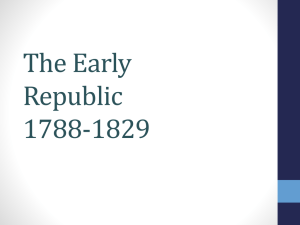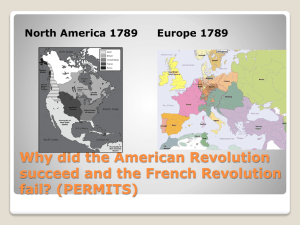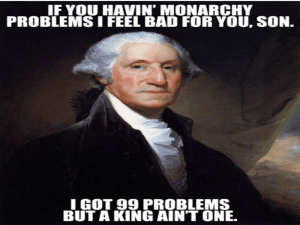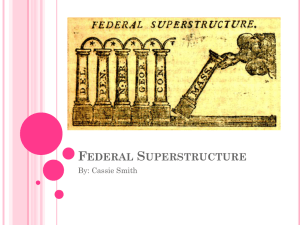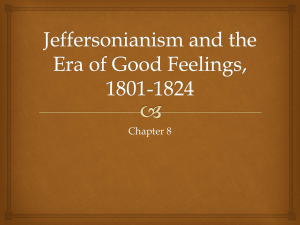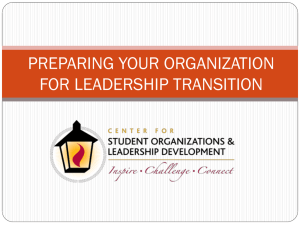Early Years PowerPoint - Newfield School District
advertisement
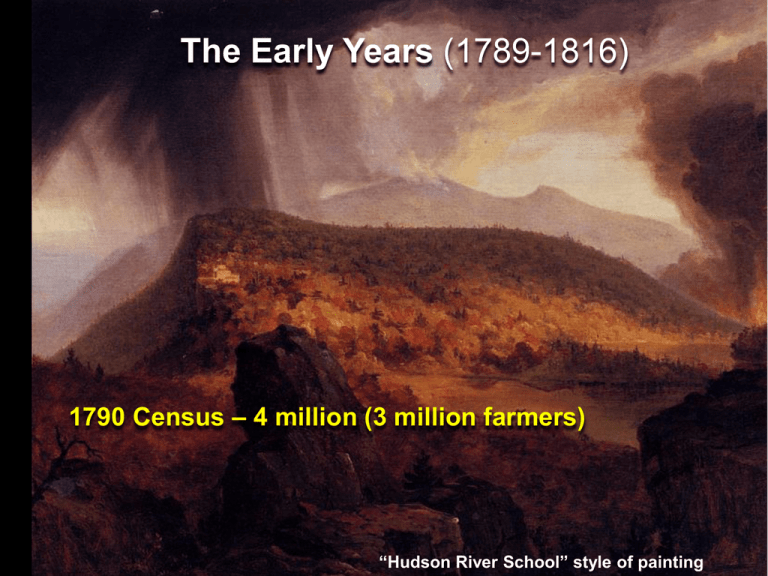
The Early Years (1789-1816) 1790 Census – 4 million (3 million farmers) “Hudson River School” style of painting Families 0f 10-12 were not unusual The FRONTIER moved from East to West The FRONTIER moves WEST This is bad news for what group of people? Population density - now Native American reservations - now I. Washington’s Presidency What do we do? This has never been done before! The Constitution didn’t spell out a lot of details There were no precedents (prior examples) Main idea – President Washington transforms the Constitution into a real government. Filling in the details… The Judiciary Act of 1789 Creates the system of Federal Judges, makes federal laws “the supreme Law of the Land” The president’s cabinet The group of department heads who serve as the president’s chief advisors Advise me. Advise me. http://www.youtube.com/watch?v=a5jzwQm69uU The National Bank Debate Alexander Hamilton Jefferson, you poor, naïve fool, we need a national bank to issue paper money and take in taxes. Plus, it will make people trust the government more. Thomas Jefferson Hamilton, you dunce, a national bank will make the government and rich investors too powerful. Oh, and PS…it’s unconstitutional! Congress doesn’t have the power to create a bank! Likes a strong central government Distrusts a strong government, and the rich Distrusts the ‘mob’ Supports the ‘plain people’ Favors development of business, manufacturing and shipping Favors a society of farmercitizens Republic led by welleducated elite http://www.youtube.com/watch?v=Urx KOO0nKwc Loose construction of the Constitution Broad (or loose) interpretation of the language of the Constitution, especially the ‘elastic clause’ Strict construction of the Constitution Literal (or strict) interpretation of the language in the Constitution. The Hamiltonians win, and the Bank of the United States is established in 1791 First Bank of the United States Philadelphia, PA The District of Columbia is designated as the new capital in 1790 Moved to the ‘center’ of the country To make southern states feel more included in the government Uninhabited parts2014 of the U.S. - 2014 The new political parties emerge Democratic Party Republican Party Philosophy: Liberal Conservative Economic Ideas: Favor minimum wages and progressive taxation i.e. higher tax rates for higher income brackets. Believe taxes shouldn't be increased for anyone (including the wealthy) and that wages should be set by the free market. Stand on Military issues: Decreased spending Increased spending Stand on gay marriage: Support (some Democrats disagree) Oppose (some Republicans disagree) Based on Social and human community and ideas: social responsibility Based on individual rights and justice Traditionally strong in states: California, Massachusetts Oklahoma, Kansas, Texas Symbol: Donkey Elephant Where 50% of Americans live Red = Republican Party Blue = Democratic Party Events in Europe divide public opinion The USA stays neutral during the French Revolution. Pinckney’s Treaty (1795) Spain gives up all claims of land east of the Mississippi (except Florida) The Northwest Territory Problems - British forts remained, and the Native Americans were fighting settlement of the territory The Northwest Territory “Mad Anthony” Wayne The Battle of Fallen Timbers (1794) decisive battle between US Army and Native American tribes, ending hostilities with the Native Americans (for the time being…) Jay’s Treaty (1794) Britain agrees to remove its forts from the Northwest Territory Battle Of Fallen Timbers - YouTube The Northwest Territory http://upload.wikimedia.org/wikipedia/commons/4/40/Non-Native-American-NationsTerritorial-Claims-over-NAFTA-countries-1750-2008.gif Washington’s Farewell Address Warns against the Party System, and foreign alliances We must be unified at home and independent abroad. John Adams becomes the second president 1797 He’s a federalist, from Massachusetts The ‘Quasi-war’ with France (1798-1800) “undeclared” war with France Have Mr. Githler arrested. Sectionalism Placing the interests of your own region ahead of the interests of the nation as a whole 1990 1860 Nullification is a legal theory that a state has the right to nullify, or invalidate, any federal law which that state has deemed unconstitutional. Thomas Jefferson becomes president - 1801 Jefferson simplified the presidency, tried to shrink the government and expanded the size of the country About Sally Hemings - YouTube Loose construction of the Constitution Broad (or loose) interpretation of the language of the Constitution, especially the ‘elastic clause’ Strict construction of the Constitution Literal (or strict) interpretation of the language in the Constitution. Marbury v. Madison The Supreme Court rules that it has the power to abolish legislative acts by declaring them unconstitutional (known as ‘judicial review’) Louisiana purchase So much for “strict construction”… I must find a way to buy that land from Napoleon… Lewis and clark War of 1812 Grievances against Britain - Impressment of U.S. sailors Interference with Indian uprisings Seizing American ships Tecumseh War of 1812 Quotes “We have met the enemy and they are ours” “Don’t give up the ship” The Star Spangled Banner “Old Hickory” (Andrew Jackson) This is The War of 1812 - YouTube Newfield The British burn the White House James Madison A war with England seemed like a good idea at the time… Results of the war War of 1812 American Confirmed independence Strengthened nationalism/our national identity New heroes A military draw The Watkins and Flint Purchase Newfield After the Revolutionary War, was a period of lively land speculation in western New York. In 1794, John Watkins and Royal Flint became land agents, and received from New York State a patent for land south of the Military Tract which had been set aside for use as payment to Revolutionary War soldiers. The patent consisted of 336,000 acres in twelve townships, at $.40 an acre, and included the area that is now Newfield. What would later become Newfield village was part of the Thomas Livingston purchase from WatkinsFlint. Land in the area typically sold for $3.00 to $4.00 an acre, paid in equal installments over a number (usually four) of years. The deed would not be recorded until the price was paid in full. In those early years, cash was hard to come by and the economy was based on barter. Very often, the purchaser would fail to make his payments and would forfeit the money already paid and title to the land would revert to the seller. In fact, only one such sale was officially recorded before 1822. Newfield in 1815 – population about 1000 The first settler was James Thomas in Poney Hollow in about 1800. About the same time, though they remained residents of Ithaca, the Dean family settled what is now the West Branch of Cayuga Inlet, and were founders of the present village on the site of an Indian village named “Three Springs” (near the corner of Main Street and Shaffer Road). The Deans were investors from Ithaca, and their settlement was called “Florence”. A mill was constructed behind where the town hall is presently located, and another mill at the intersection of Mill Street and Depot Road. In the first decade, a saw mill (1809) and then a grist mill (1811) were erected along the stream. The walls that can be seen today behind the town hall were from mills that were constructed somewhat later – probably around 1830. There was also a hotel and tavern operated by Jeremiah Hall. There was no bridge until 1812 and the roads were little better than improved Indian trails. As a result, agricultural activity in the township was mostly subsistence farming. Generally, settlers at the lower altitudes had better land and a longer growing season than those in the hills. There was no easy way at that time to transport products (or people) to other places. Life was quite different in those early years. Mail was carried between Ithaca and Elmira once a week on horseback, weather permitting. Most of the structures were made of logs. Perhaps the biggest threats to livestock were the numerous wolves. Bears and rattlesnakes were common, too. There was a log schoolhouse, but no churches, and residents had to rely on infrequent visits by circuit preachers. Alexander Hamilton Thomas Jefferson Likes a strong central government Distrusts a strong government, and the rich Distrusts the ‘mob’ Supports the ‘plain people’ Favors development of business, manufacturing and shipping Favors a society of farmercitizens Republic led by welleducated elite



